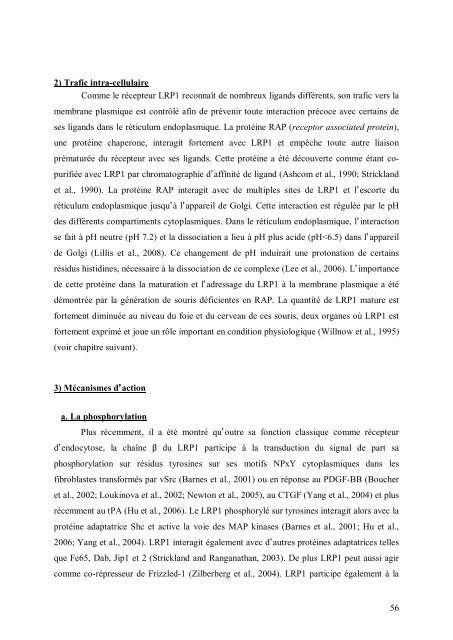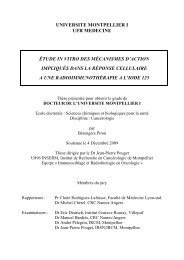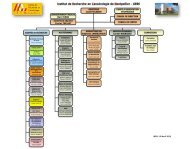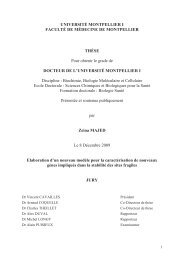- Page 1 and 2:
Université Montpellier I UFR Méd
- Page 3 and 4:
Un grand merci à tous mes collabor
- Page 5 and 6: TitleBreast cancer and tumoral micr
- Page 7 and 8: Cancer du sein et micro-environneme
- Page 9 and 10: C. PRESENTATION DU TRAVAIL DE THESE
- Page 11 and 12: But de la thèseLa cathepsine-D (ca
- Page 13 and 14: I. Le tissu adipeux1) Généralité
- Page 15 and 16: (Adenosine triphosphate). Cette pro
- Page 18 and 19: Cette synthèse de novo a lieu dans
- Page 20 and 21: ABFigure 6 : Schéma de la oxydati
- Page 22 and 23: d. Ladipocyte : une cellule sécré
- Page 24 and 25: 3) Ladipogenèsea. Les différentes
- Page 26 and 27: . Les facteurs de transcriptionLa d
- Page 28 and 29: Lexpression de C/EBP est quant à e
- Page 30 and 31: adipeux. Les analyses histologiques
- Page 32 and 33: adipocyteFigure 10 : Schéma repré
- Page 34 and 35: II. La cathepsine-D1) Synthèse, ma
- Page 36 and 37: les cath-B et L, en une forme matur
- Page 38 and 39: Il existe deux RM6P : le RM6P/IGFII
- Page 40 and 41: 2) Fonctions de la cath-Da. Dans la
- Page 42 and 43: . Dans les pathologiesEn plus de se
- Page 44 and 45: c. Rôles et mécanismes daction da
- Page 46 and 47: carcinome de prostate serait respon
- Page 48 and 49: La cath-D joue donc un rôle import
- Page 50 and 51: Une fois le marquage des peptides e
- Page 52 and 53: Afin de réaliser ce projet, nous a
- Page 54 and 55: III. Le récepteur LRP11) Organisat
- Page 58 and 59: LRP1αLRP1Membrane associatedprotea
- Page 60 and 61: Tableau 3 : Ligands connus du LRP1(
- Page 62 and 63: I. Etude du rôle de la cathepsine
- Page 64 and 65: Cathepsin-D, a key protease in brea
- Page 66 and 67: IntroductionConsumption of meals ri
- Page 68 and 69: (Fig. 1A, panel a). This differenti
- Page 70 and 71: differentiated adipocyte (Fig. 4B).
- Page 72 and 73: DiscussionOur results demonstrate t
- Page 74 and 75: from normal and peri-al breast adip
- Page 76 and 77: mouse RS9 (sens 5CGGCCCGGGAGCTGTTGA
- Page 78 and 79: agreement of local ethic committee.
- Page 80 and 81: Statistical analysis. Results are e
- Page 82 and 83: Loncarek J, Freiss G, Vignon F and
- Page 84 and 85: Aa3000 *b4000*B8000**cath-D mRNA(ar
- Page 86 and 87: ABcath-D mRNA(ratio RS9)PPARg mRNA(
- Page 88 and 89: A D3 D7 D14D0BaD0 D3 D7 D14D0 D3 D7
- Page 90 and 91: AshLucshcath-DF442A C34 C37 A4 D10c
- Page 92 and 93: AF442-AC34C37A4D10BF442-AC34C37A4D1
- Page 94 and 95: II. Etude du rôle du LRP1 dans les
- Page 96 and 97: 2) Article 2:LRP1 receptor controls
- Page 98 and 99: LRP1, Adipogenesis, Obesityrelative
- Page 100 and 101: LRP1, Adipogenesis, ObesityFigure 3
- Page 102 and 103: LRP1, Adipogenesis, ObesityFigure 5
- Page 104 and 105: LRP1, Adipogenesis, ObesitySome ins
- Page 106 and 107:
LRP1, Adipogenesis, ObesityLipolysi
- Page 108 and 109:
CONCLUSIONLa cathepsine D (cath-D)
- Page 110 and 111:
la souris obèses. Enfin, linhibiti
- Page 112 and 113:
carcinogénique sont encore mal con
- Page 114 and 115:
Ce travail de thèse a étudié, po
- Page 116 and 117:
REFERENCESAhima, R. S. (2006). Adip
- Page 118 and 119:
implicates them as antigen presenti
- Page 120 and 121:
Cataldo, A. M., Barnett, J. L., Ber
- Page 122 and 123:
Folkman, J. (2003). Fundamental con
- Page 124 and 125:
Hofmann, S. M., Zhou, L., Perez-Til
- Page 126 and 127:
Langin, D. (2006a). Adipose tissue
- Page 128 and 129:
Ludwig, T., Ovitt, C. E., Bauer, U.
- Page 130 and 131:
Nirde, P., Derocq, D., Maynadier, M
- Page 132 and 133:
Rozanov, D. V., Hahn-Dantona, E., S
- Page 134 and 135:
Taleb, S., Cancello, R., Clement, K
- Page 136 and 137:
Xiao, Y., Junfeng, H., Tianhong, L.
- Page 138 and 139:
F. ANNEXE98
- Page 140 and 141:
Cathepsin D is a new ligand for ext
- Page 142 and 143:
INTRODUCTIONLysosomal aspartic prot
- Page 144 and 145:
pcDNA3.1(+)Myc-tagged LRP1b into pc
- Page 146 and 147:
(Protein refolding kit, Novagen) fo
- Page 148 and 149:
anti-mouse-gold (Aurion). Sections
- Page 150 and 151:
not secrete detectable levels of pr
- Page 152 and 153:
using cath-D-/- MEF transfected wit
- Page 154 and 155:
co-culture outgrowth assays with ca
- Page 156 and 157:
REFERENCES1. Vignon, F., Capony, F.
- Page 158 and 159:
steps in vivo: proliferation, angio
- Page 160 and 161:
28. Laurent-Matha, V., Lucas, A., H
- Page 162 and 163:
42. Zurhove, K., Nakajima, C., Herz
- Page 164 and 165:
Figure 1. Cath-D interacts with the
- Page 166 and 167:
Figure 2. Cath-D binds to residues
- Page 168 and 169:
Figure 3. Cath-D interacts with LRP
- Page 170 and 171:
Figure 5. Silencing LRP1 in cath-D
- Page 172 and 173:
Figure 1. Cath-D interacts with the
- Page 174 and 175:
Figure 6. LRP1 is the receptor medi
- Page 176 and 177:
Beaujouin, Figure Sup. 2cath-D-/-ME
- Page 178:
RésuméLaspartyl protéase catheps





